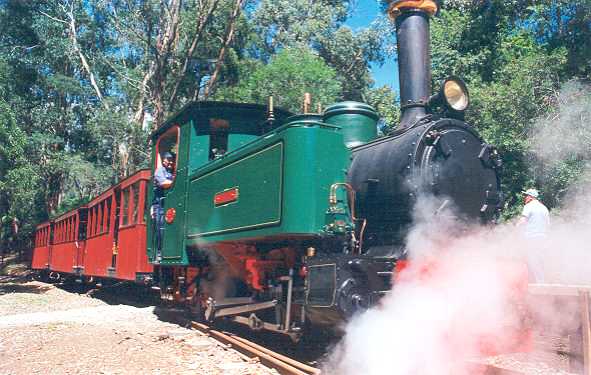|
|
Bingera Mill ‘Kolan’ Coal Creek Community Park & Museum |
|

The former Bingera Mill ‘Kolan’, now named ‘Count
Strzelecki’, seen at Coal Creek Top Station (since renamed Ruddville Station).
Originally the locomotive carried a
balloon stack for cane haulage duties rather than this ornate copper-top
chimney.
My thanks to John O’Neill for contributing this view
(scanned from a print) circa 2001.
|
Bundaberg Foundry Engineers Ltd |
|
|
Builder’s Number & Year |
7 of 1953 |
|
Wheel Arrangement |
0-6-2T |
|
The Bundy Fowler locos The well-known manufacturer John Fowler &
Co, Leeds, UK built many steam locomotives for the Australian sugar cane
industry, where their products were held in high regard. In 1935, John Fowler
& Co made a strategic decision to cease manufacture of steam locomotives
in favour of internal combustion designs, leaving a market gap in the
Australian sugar industry where demand for steam locomotives remained.
Stepping in to fill this gap were Australian companies Perry Engineering in
Adelaide, and Bundaberg Foundry Engineers Ltd (Bundaberg Foundry) who leveraged
their established heavy engineering business serving the cane mills of
Queensland’s Burnett Region and beyond. By 1948, Bundaberg Foundry had obtained firm
orders from various mills for 8 steam locomotives based on recent John Fowler
& Co designs operating at Queensland mills, in particular 0-6-2T ‘Airdmillan’ (Fowler b/n 20763 of 1935), and with modernisations
such as roller-bearing axles. It seems a licence was eventually negotiated
with John Fowler & Co, but steel supply proved problematic in the
post-war years and the first loco was not completed until 1952. A single
0-4-2T version was among the 8 constructed. These antipodean Fowler cousins
became known as ‘Bundy Fowlers’ and were not only among the last steam
locomotives built in Australia, but also among the last in revenue service –
with all 8 Bundaberg-Fowler steam locomotives ultimately passing into
preservation. John Browning and Brian Webber have written a
comprehensive and well-illustrated account of the various steam and diesel
locomotives built and reconstructed by Bundaberg Foundry Engineers Limited in
‘Built by Bundaberg Foundry’ as referenced below. Rather than repeat the
information provided in that authorative work, I have sought here to provide
a brief background to the Bundy-Fowler steam locomotives and their
preservation careers. Bingera Mill ‘Kolan’ Bingera Mill, situated to the west of
Bundaberg and near the Burnett River, ordered two Bundy Fowler locomotives,
the first being b/n 4 which arrived in 1952 and received the name ‘Ralf’
followed by b/n 7 which arrived in 1953 and received the name ‘Kolan’ after the local Kolan Shire. Both toiled in cane fields
during the harvest season, hauling heavy loads of cut sugar cane from the
fields to the mill for processing and returning to the fields with long
strings of empties for refilling. ‘Kolan’ laboured in cane haulage at Bingera
Mill for 19 years before being retired in 1972. From 1975 ‘Kolan’ was displayed as a static
exhibit at the former Boyds Antiquarium in Bundaberg. In 1997 ‘Kolan’ was sold to a private owner
and relocated to the Coal Creek Community Park & Museum at Korumburra,
Victoria, where the loco was thoroughly rebuilt and returned to service,
including provision of a beautiful copper-top chimney in place of the
original balloon stack. Renamed ‘Count Strzelecki’ at Coal Creek, it now
hauls visitors on a bushland loop track in the lower half of the museum site;
apparently this line has steep grades and the regulator does get some use! I
understand a small diesel locomotive deputises on running days if the steam
loco is unavailable due to overhaul or fire bans. Black Coal mining at Korumburra has an
interesting history, with the first underground mines being established in
1878. Indeed the township of Korumburra was originally known as Coal Creek.
The long-closed Outtrim branch line once joined at Korumburra station, and
itself had a branch line passing the village site to local mines; the route
of this line can just be traced on Google Earth as it passes the Coal Creek
Village site to former mines nearby. The Coal Creek Community Park & Museum hosts many historic
local buildings which have been carefully relocated and restored to create a
village setting focussed around an old coal mine, including a recreated
railway station and goods yard featuring Victorian Railways 2-8-0 loco K169, carriages, wagons
and a brake van. The webmaster enjoyed a visit to Coal Creek during December
1998 but alas it wasn’t a railway running day and I had to be content with
spying the Bundy Fowler through a crack in the engine shed doors! The contribution of additional photos of
Kolan / Count Strzelecki in operation at Coal Creek would be much
appreciated. |
References
|
a |
Light
Railway Research Society of Australia Inc. Web site (Retrieved
3 November 2018): 'Preserved
Australian Sugar Cane Locomotives' list by John Browning |
|
b |
Website for Bundaberg Walkers Engineering
Ltd, retrieved
12 September 2022 |
|
c |
Browning J.
& Webber B. ‘Built
by Bundaberg Foundry’, published 2012 by the Australian
Narrow Gauge Railway Museum Society, Woodford QLD ISBN
978-0-9596009-4-0 |
|
|
|
Page updated: 11 December 2022
|
Government Railways: |
|
|||||||||
|
Private & Industrial Railways: |
|